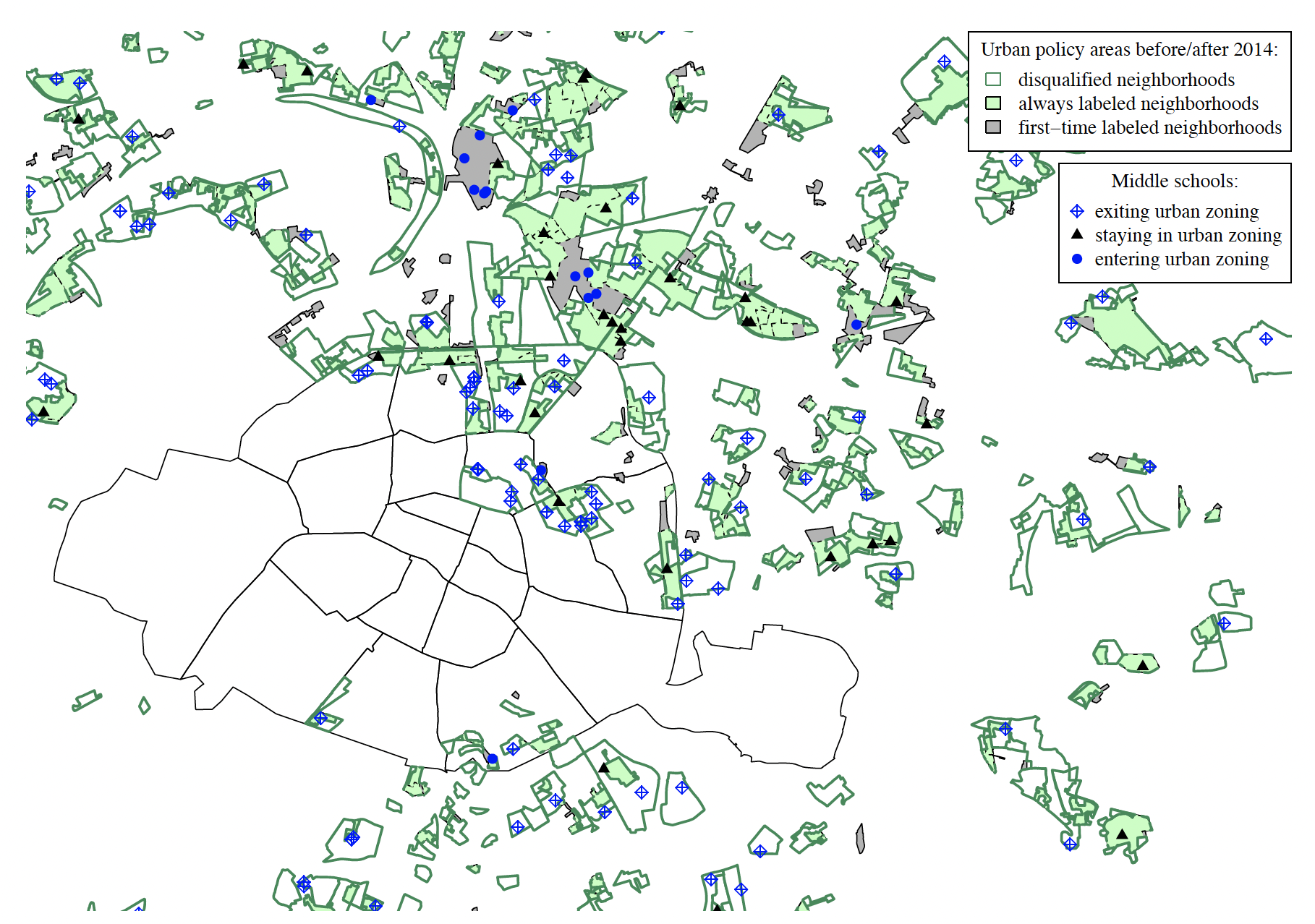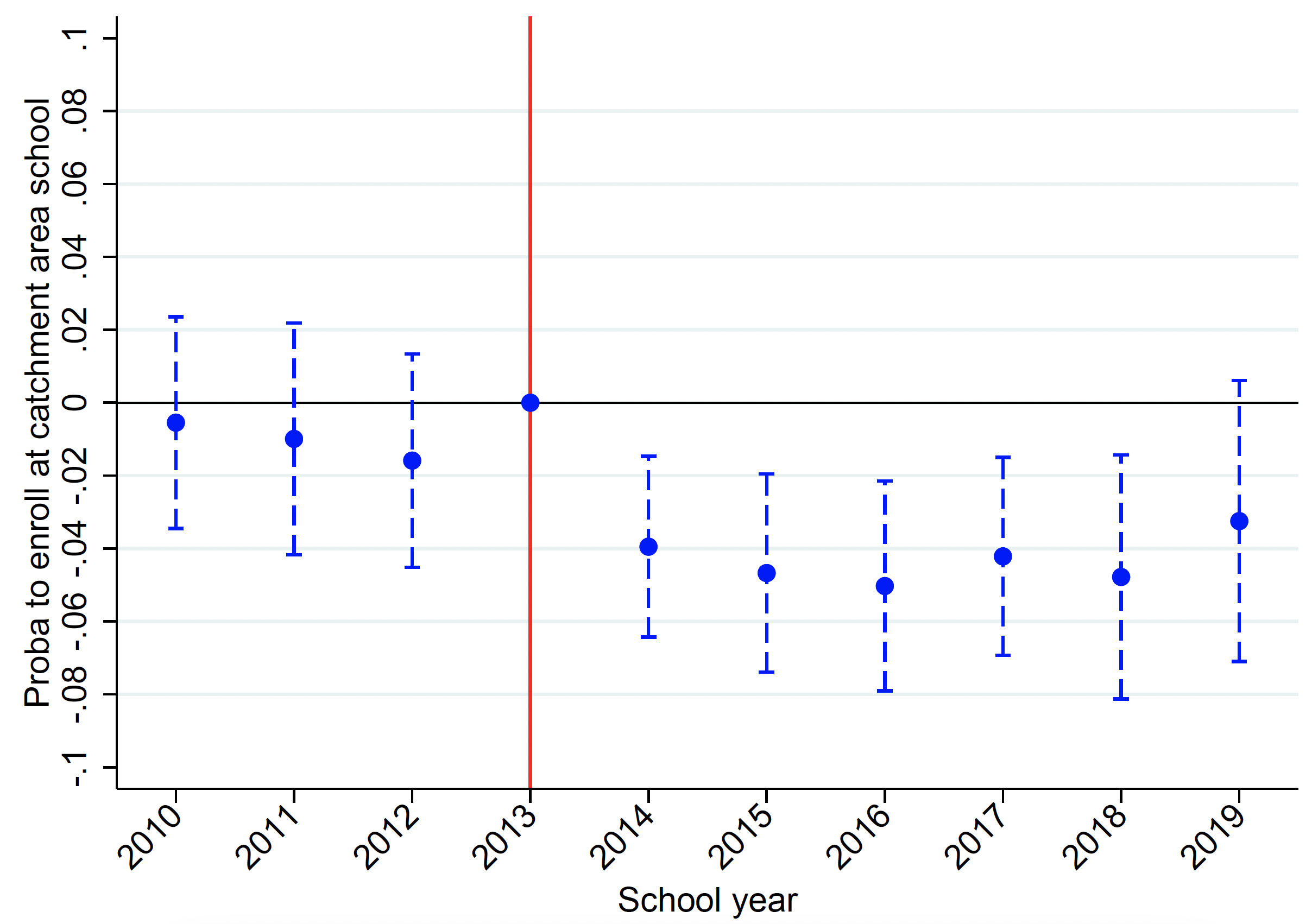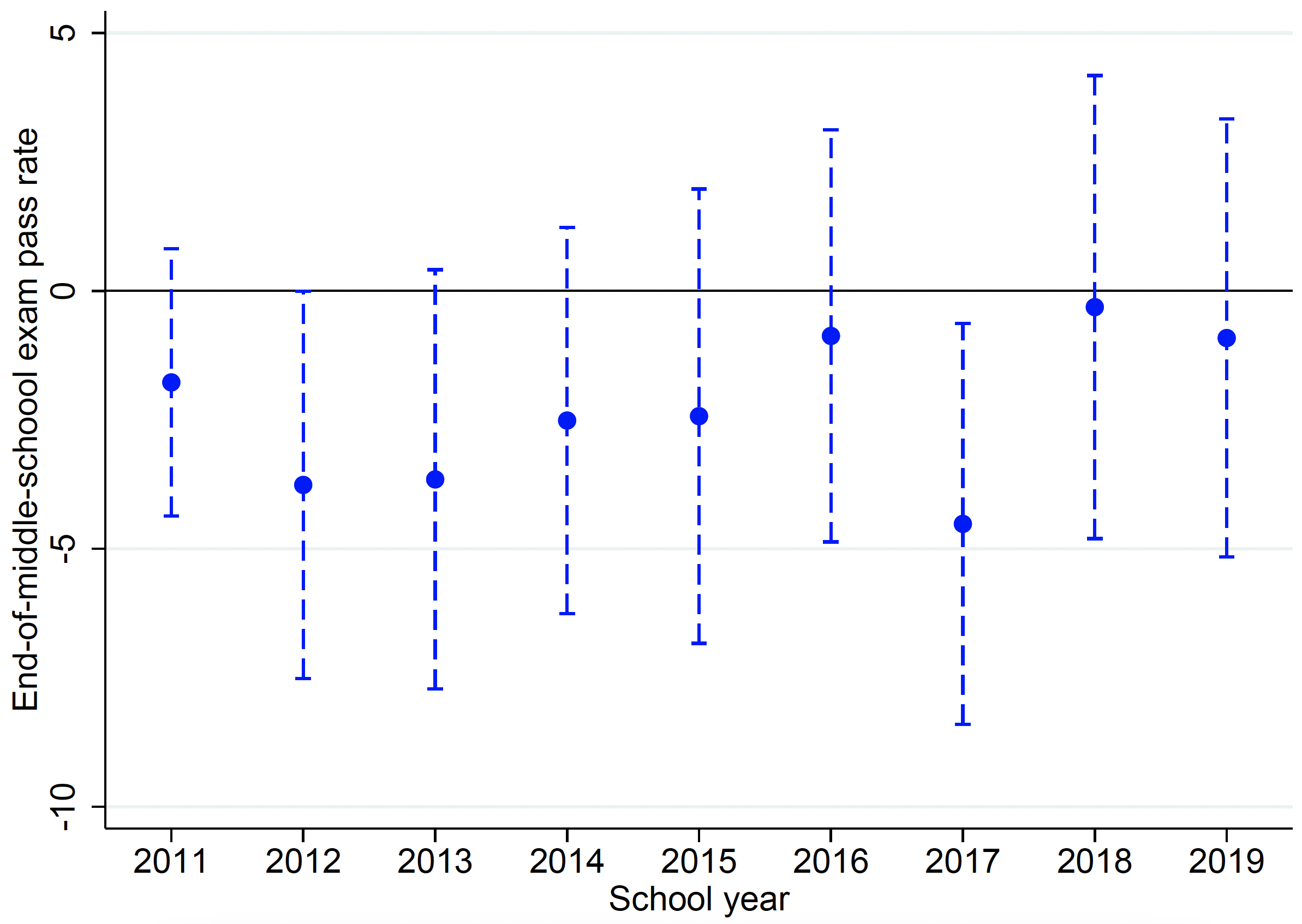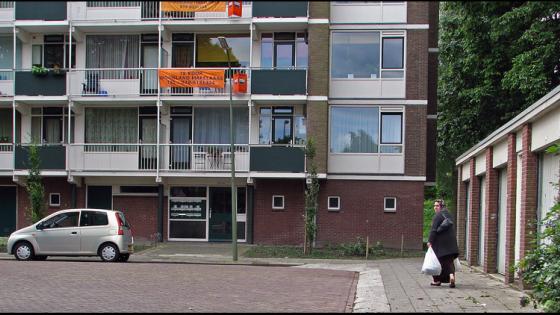To tackle ever-growing socioeconomic disparities within cities, for more than 40 years policymakers worldwide have implemented place-based policies such as enterprise zones to foster employment and agglomeration economies in low-income neighbourhoods and to improve the living conditions of their residents (Bartik 2020, Neumark and Simpson 2015). To what extent such policies succeed in reviving the targeted areas is, however, a hotly debated question among economists. While tax rebates and wage credits conditional on plant location are particularly successful in attracting businesses and creating jobs in deprived areas (Busso et al. 2013, Criscuolo et al. 2019, Ku et al 2020), these benefits may either come at the expense of untargeted neighbourhoods (Briant et al. 2015, Mayer et al. 2017, van Ehrlich and Seidel 2018, Einiö and Overman 2020) or accrue to an initially untargeted population (Charnoz 2018, Barone and Biaso 2023). There is also recent evidence showing that ‘redlining’ or ‘labelling’ places may even stigmatise them in various ways (Koster and van Ommeren 2022, Dominguéz et al. 2022, Andersson et al. 2023).
In a recent paper (Garrouste and Lafourcade, 2023), we analyse the issue of territorial stigmatisation through the lens of school enrollment and educational attainment in France. These are key outcomes when discussing place-based redistribution, as the former outcome is a measure of revealed preferences for neighbourhoods and the later an extremely powerful determinant of intergenerational mobility (Chetty and Hendren 2018). Moreover, France is a relevant context to study the impact of place-based policies on schooling outcomes, as spatially targeted incentives there involve substantial subsidies to education. These well-meaning resources can obviously increase demand for schools located in low-income areas, as parents may legitimately expect them to help their children to perform better (Jackson and Mackevicius 2021). However, they may also alter the reputation of schools if parents face informational frictions about school quality, and if policy designation conveys a negative image of the targeted neighbourhoods.
Quantifying the ‘net’ impact of place-based redistribution on school outcomes is particularly challenging, however, when pupils are assigned to public schools based on a catchment area system, as is the case in France. As such, residential sorting and social segregation at school reinforce each other, because families consider the quality and reputation of schools when choosing where to settle. It is therefore not trivial to disentangle what comes from the policy and what comes from either the neighbourhood or school attributes. We overcome this identification challenge by exploiting the quasi-natural experiment provided by a reform that redrew the map of neighbourhoods eligible for place-based subsidies in France.
The 2014 policy reform
From 2014, to target public resources to the most distressed urban neighbourhoods, the French government changed the selection criterion of eligible areas, which had not been revised for a long time. Thereafter, only neighbourhoods below a poverty threshold (calculated as 60% of a weighted average of the nationwide and citywide median incomes) were declared eligible for place-based redistribution. Eligible areas were selected upon a very granular geographical scan of France, whereby all contiguous 200 metre squares with a median income below the poverty threshold were amalgamated to form the targeted zones. Furthermore, in an effort to make the policy more transparent, the French government developed online search engines giving precise information on the delineation of new eligible areas, so-called ‘priority neighbourhoods’, which contributed to officialising and mediatising the treatment status of neighbourhoods.
After the reform, some areas previously targeted by place-based subsidies no longer qualified for public support as their median income lay above the poverty threshold, while some previously untargeted neighbourhoods became eligible because they met the new policy criterion. As such, without any change in school catchment-areas at the time of the reform, schools located in newly eligible neighbourhoods started to be covered by the policy, whereas schools in no-longer eligible neighbourhoods stopped being covered. Figure 1 illustrates the substantial reshuffling of public middle schools across treated and untreated neighbourhoods brought on by the reform in the Paris region.
As the reform was based on a unpredictable and non-manipulable poverty cut-off, we exploit these spatio-temporal shifts all over France to examine whether middle schools located in neighbourhoods lying below (above) the poverty threshold witnessed significant changes in pupil enrollment and performance after the neighbourhood became (stopped being) eligible, compared to middle schools in neighbourhoods on the other side of the policy threshold.
Figure 1 The 2014 place-based policy reform in the Paris area
Note: Boundaries of Parisian arrondissements in black. Hollow green (resp. filled grey) polygons represent neighbourhoods that ‘exited’ (‘entered’) policy zoning, and filled green polygons those that had and continue to have policy-coverage. Hollow blue diamonds (solid blue circles) represent middle schools that ‘exited’ (‘entered’) policy coverage, and solid black triangles those that had and continue to have policy coverage.
Source: Garrouste and Lafourcade (2023).
Stigma effects from policy designation
The results show strong evidence of stigma effects from policy designation, as public middle schools in newly labelled neighbourhoods saw a significant 4 percentage point drop in pupil enrollment immediately after policy designation, compared to their counterfactual analogues in undesignated areas just above the poverty threshold (see Figure 2). This ‘zone and shame’ effect is immediate, persists up to five years after policy labelling, and is triggered by the reactions of parents from all socioeconomic backgrounds, who avoided public schools in policy areas and shifted to those in non-policy areas or (only for wealthy parents) to private schools. There is also evidence of a later decrease in pupils’ test scores associated with this spatial resorting (see Figure 3), which would be consistent with high-achieving peers fleeing the targeted areas. In contrast, we uncover only weak evidence of stigma reversal after an area loses its policy status, suggesting hysteresis in bad reputations. We find no evidence of a ‘Tiebout flight’ post-reform, suggesting that parents re-sorted across schools (by either requesting a derogation to enroll their child in a public school outside their catchment area or by switching to the private sector),
rather than across areas (by moving to another neighbourhood).
Figure 2 Probability of choosing the catchment area public school at the entry of lower secondary education pre- and post-policy designation
Note: The X-axis displays school years (2010 stands for the school year 2010/11), with 2013 as the reference. The Y-axis displays the difference in the estimated probabilities to choose public middle schools in newly labelled neighbourhoods and never-labelled counterfactual neighbourhoods. 90% confidence intervals in dash blue.
Source: Garrouste and Lafourcade (2023).
Figure 3 Policy designation and students' performance at the end of lower secondary education
Note: The X-axis displays school years (2010 stands for the school year 2010/11), with 2010 as the reference. The Y-axis plots the estimated gap in exam pass-rates for public middle schools between newly labelled neighbourhoods and never-labelled counterfactual neighbourhoods. 90% confidence intervals in dash blue.
These stigma effects may be hard to undo: we find no symmetric positive compensation from loss of policy status, as the perception of school quality among wealthy families does not change in response to a neighbourhood no longer qualifying for the policy. Moreover, in educational contexts other than France, where school catchment areas may not exist and parents may have greater leeway to choose between several public schools, territorial stigmatisation from policy designation may well appear with more salience or persistence. In any case, when discussing the desirability of place-based education subsidies, these results raise the question of whether to design student-based rather than place-based policies to avoid such stigma effects.
References
Aaronson, D, D Hartley, B Mazumder, and M Stinson (forthcoming), “The long-run effects of the 1930s redlining maps on children”, Journal of Economic Literature.
Andersson, H, I Blind, F Brunåker, M Dahlberg, G Fredriksson, J Granath, and C-Y Liang (2023), “What’s in a label? on neighbourhood labelling, stigma and house prices”, Working Paper, Uppsala University.
Barone, G and G de Blasio (2023), “Place-based policies in the Italian case, part 2: Mind the negative side effects”, VoxEU.org, 1 February.
Bartik, T J (2020), “Using place-based jobs policies to help distressed communities”, Journal of Economic Perspectives 34(3): 99-127.
Briant, A, M Lafourcade, and B Schmutz (2015), “Can tax breaks beat geography? Lessons from the French enterprise zone experience”, American Economic Journal: Economic Policy 7(2): 88-124.
Busso, M, J Gregory, and P Kline (2013), “Assessing the incidence and efficiency of a prominent place-based policy”, American Economic Review 103(2): 897-947.
Charnoz, P (2018), “Do enterprise zones help residents? Evidence from France”, Annals of Economics and Statistics (130): 199-225.
Chetty, R and N Hendren (2018), “The Impacts of Neighborhoods on Intergenerational Mobility I: Childhood Exposure Effects”, The Quarterly Journal of Economics 133(3): 1107-1162.
Criscuolo, C, R Martin, H G Overman, and J van Reenen (2019), “Some causal effects of an industrial policy”, American Economic Review 109(1): 48-85.
Domínguez, M, H Grönqvist, and T Santavirta (2023), “Neighborhood labeling and youth schooling paths”, Working Paper, Uppsala University.
Einiö, E and H G Overman (2020), “The effects of supporting local business: Evidence from the UK”, Regional Science and Urban Economics 83, 103500.
Garrouste, M, and M Lafourcade (2022), "Place-Based Policies: Opportunity for Deprived Schools or Zone-and-Shame Effect?", CEPR Discussion Paper 17750.
Jackson, C K, and C Mackevicius (2021), “The distribution of school spending impacts“, NBER Working Paper 28517.
Koster, H R A, and J van Ommeren (2022), “Neighbourhood stigma and place-based policies”, Economic Policy, eiac039.
Schönberg, U, R C Schreiner, and H Ku (2020), “Place-based payroll taxes and regional employment”, VoxEU.org, 15 February.
Mayer, T, F Mayneris, and L Py (2017), “The impact of Urban Enterprise Zones on establishment location decisions and labor market outcomes: Evidence from France”, Journal of Economic Geography 17: 709-752.
Neumark, D, and H Simpson (2015), “Place-Based Policies”, in J V Gilles Duranton, and W C Strange (eds), Handbook of Regional and Urban Economics, Vol. 5, Elsevier.
van Ehrlich, M and T Seidel (2018), “The persistent effects of place-based policy: Evidence from the West German zonenrandgebiet”, American Economic Journal: Economic Policy 10(4): 344–374.






